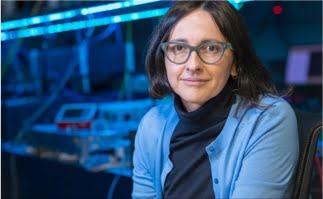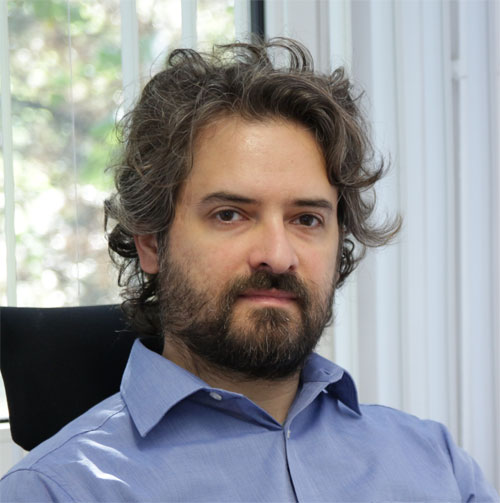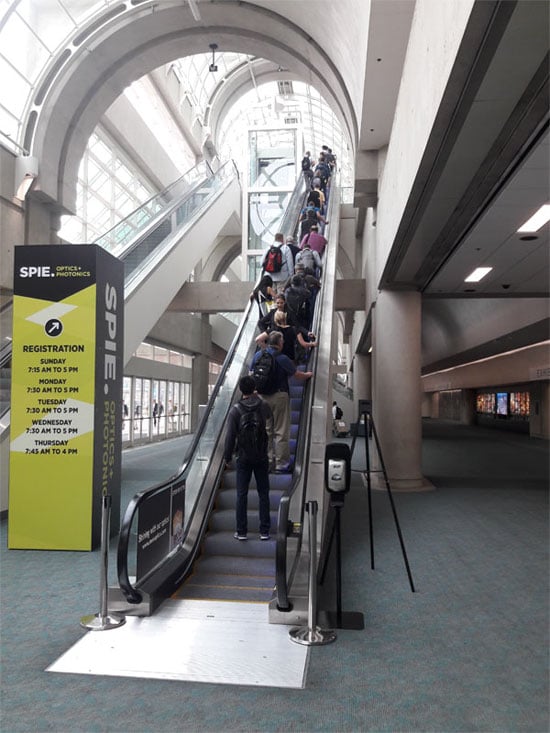BY HANK HOGAN, CONTRIBUTING EDITOR
SAN DIEGO, Aug. 15, 2019 — For photonics, forward progress may start by going in reverse — when it makes sense. That was a theme in the SPIE Optics + Photonics conference held in San Diego Aug. 11-15.
An example showed up in a plenary talk given by Jelena Vuckovic, a Stanford electrical engineering professor. She noted that state-of-the-art photonics leave something to be desired.
“Components are pretty bulky. They’re very sensitive to fabrication errors, temperature variations, and so on,” she said.

Professor Jelena Vuckovic. Courtesy of Stanford University.
In the standard approach, designers start with building blocks, such as photonic switches, and put these together to create, say, a multiplexer. Figuring out how best to do this with brute force simulations only works well for the simplest cases.
A better solution, said Vuckovic, is to attack the problem in reverse using inverse design. In it, designers start with a desired outcome – for example, a three-signal multiplexer with a certain maximum size, a minimum efficiency, and other characteristics. Then software tries a component combination, makes an adjustment, and tries again. If the new solution is closer to the target than the last, then it becomes the starting point and the process repeats. If not, the software tries a different adjustment.
This can be thought of like walking over a hilly area looking for a valley. If headed downhill, keep moving. If not, change direction; when at a low enough point, stop.
The layout that results from inverse design doesn’t look intuitive or like anything people create. But there have been some impressive results, such as photonic solutions that efficiently and compactly transmit light in one direction but not the other. This nonreciprocal transmission could be useful in lidar. Inverse design also could be used to build photonic particle accelerators, thereby shrinking powerful x-ray sources to a few inches of silicon. A third application that could be helped is the photonic interconnect between quantum bits, or qubits. These interconnects must be highly efficient for quantum computing and communication to work, and inverse design may offer solutions that accomplish this.
Inverse design software developed by the Stanford team is already being employed commercially, according to Vuckovic. There also is an open source version available.
What’s more, the resulting devices can be built using standard processes. “All of this is foundry compatible,” Vuckovic said.
In a Q&A after her talk, she did note the software can be given an impossible task, such as fitting components into too small of a space. Work is underway to set such bounds analytically, so the software isn’t asked to do the impossible. Currently, this is done manually through trial and error.

Professor Giovanni Volpe. Courtesy of Bilkent University.
Working backward was also discussed in another plenary talk. Giovanni Volpe, an associate professor at Sweden’s Götesborgs University, discussed optical trapping. A basis of multiple Nobel prizes, the technique has applications in physics, biology, and chemistry.
For example, a trapped particle that absorbs light can be turned into a micro- or nanoscale motor. As the particle absorbs light, it heats up, and the temperature rise can lead to movement. This can be exploited to do work.
“We can control or tune the behavior of this system,” Volpe said. Changing the laser power or the temperature of the liquid mixture alters the movement, its frequency, or both.
But further progress in this and other nanoscale applications may well depend on machine learning, Volpe said. This tool, for instance, can simulate what happens when a trapped particle is dissolving, a situation that can’t be handled analytically.

Over 4000 people attended SPIE Optics + Photonics, an international, multidisciplinary optical sciences and technology meeting, with advancements shared in over 3000 presentations. Courtesy of Hank Hogan.
The backward component here is that in machine learning, errors between the actual and the desired outcome are sent back through the system in a feedback loop. Minimizing the errors leads to the improved performance. In analyzing the forces at work in optical trapping, for example, machine learning can be as much as three or four orders of magnitude faster than the exact answer provided by an analytical solution.
There are issues to consider, of course. One involves the nature of machine learning-based solutions.
“The problem is they operate like black boxes, and so you don’t really know what they’re doing,” Volpe said.
So, going backward may take a bit of faith, as well as following new methods. The benefits, though, could well be worth it. Indeed, the future of photonics may depend on this technique and inverse design, or a combination of both.